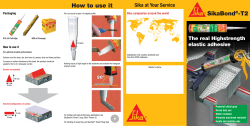
Why do earthing and bonding need to be checked? esc
Why do earthing and bonding need to be checked? www.esc.org.uk Why do earthing and bonding need to be checked? If you are having an alteration or addition made to your electrical installation, your electrician must first check (as well as other things) that the earthing and bonding arrangements you have are up to the required standard. This is because the safety of any new work (however small) will depend on the earthing and bonding (as does the safety of your existing installation). What is earthing? If there is a fault in your electrical installation you could get an electric shock if you touch a metal part that has become live due to the fault. This is because the electricity may use your body as a path from that metal part to earth. Earthing is used to protect you from an electric shock. It does this by providing a path (a protective conductor) for a fault current to flow to earth. It also causes the protective device – a circuit-breaker, fuse or residual current device (RCD) – to switch off the electricity supply to the circuit that has the fault. For example, if a cooker has a fault, the fault current flows to earth through the protective conductor. The relevant circuit-breaker, fuse or RCD in the consumer unit switches off the electrical supply to the cooker. The cooker is now safe from causing an electric shock to anyone who touches it. Fault current Protective conductor Consumer unit/ fusebox Fault current flows to Earth (via the supply cable) Earthing conductor FAULT Safety connection to Earth Cooker External meter box A circuit-breaker, RCD or fuse in the consumer unit switches OFF the faulty circuit, quickly removing the risk of electric shock What is bonding? Bonding is used to reduce the risk of electric shock to anyone who may touch two separate metal parts when there is a fault somewhere in the electricity supply or electrical installation. By connecting together the particular metal parts with bonding conductors, bonding reduces the voltage there might have been. The two types of bonding normally used are main bonding and supplementary bonding. Main bonding is always needed. You may need supplementary bonding for rooms containing a bath or shower, except where all circuits in the room are RCD protected and the main bonding is up to the required standard. Supplementary bonding Main bonding Protective conductor Consumer unit (fuseboard) Electric shower Main bonding conductor Main Earthing Terminal Fault Earthing conductor Water installation pipe Gas Meter Fault current flows to earth Supplementary bonding conductor Bonding clamp Metal pipes Main bonding conductor Definitions Bonding – A way of reducing the risk of getting an electrical shock. Conductors – Wires that carry electricity. Consumer unit – A fusebox that controls and distributes electricity around the home. It usually contains a main switch, fuses or circuit-breakers and may contain one or more residual current devices (see RCD). Current – Flowing electricity. Earth – A connection to the ground. Earthing – A way of preventing electric shocks. Electrical installation – A fixed wiring system. Live – Active (there is electricity). Main bonding – Green-and-yellow conductors that connect the hard metal pipework (gas, water or oil) from inside a building to the main earthing terminal of the electrical installation. Main bonding connections may also be made outside the building, for example where a semi-enclosed gas meter box is installed outside and it is not possible to install a bond to the gas installation pipework indoors. Main earthing terminal – A terminal block where earthing and bonding conductors are connected together. Residual current device (RCD) – An RCD, or residual current device, is a life-saving device which is designed to prevent you from getting a fatal electric shock if you touch something live, such as a bare wire. It can also provide some protection against electrical fires. RCDs offer a level of personal protection that ordinary fuses and circuit-breakers cannot provide. Supplementary bonding – Green-andyellow conductors that connect the earthing terminals of electrical equipment (such as lighting points and electric showers) to accessible metal parts of items of electrical equipment and/or accessible metal parts of items that are not electrical (such as pipes). These connections are made to prevent a dangerous voltage occurring between two accessible metal parts, in the event of a fault. Voltage – The force of electricity. More advice An electrician will give you advice if your earthing or bonding needs to be improved for safety reasons. We strongly recommend that you use an electrician registered with a government-approved scheme to carry out any electrical installation work you need doing. For details on how to find a registered electrician visit our website at www.esc.org.uk The Electrical Safety Council Unit 331-3 Great Guildford Business Square, 30 Great Guildford Street, London, SE1 0HS Phone: 020 3463 5100 Email: enquiries@esc.org.uk Web: www.esc.org.uk Fax: 020 3463 5139 Registered Charity (England and Wales) No. 257376 Registered Charity (Scotland) No. SC039990 The Electrical Safety Council (ESC) is a charity committed to reducing deaths and injuries caused by electricity. © Electrical Safety Council E&B rev 2 09/12
© Copyright 2025

















